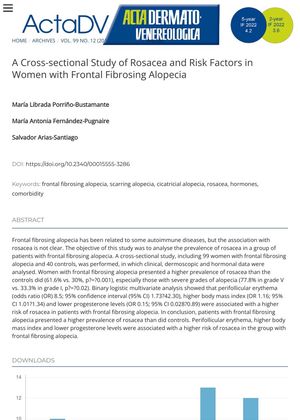A Cross-Sectional Study of Rosacea and Risk Factors in Women with Frontal Fibrosing Alopecia
January 2019
in “
Acta dermato-venereologica
”

TLDR Women with severe frontal fibrosing alopecia are more likely to have rosacea.
The study conducted in 2019 involved 99 women with frontal fibrosing alopecia and 40 controls to analyze the prevalence of rosacea in patients with frontal fibrosing alopecia. The results showed that women with frontal fibrosing alopecia had a higher prevalence of rosacea than the controls (61.6% vs. 30%). This prevalence was especially high in those with severe grades of alopecia (77.8% in grade V vs. 33.3% in grade I). The study also found that perifollicular erythema, higher body mass index, and lower progesterone levels were associated with a higher risk of rosacea in patients with frontal fibrosing alopecia.





